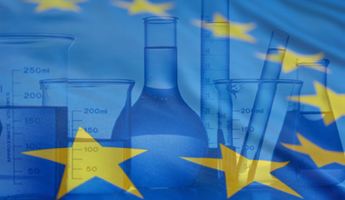Strategie pro udržitelnost v oblasti chemických látek
-
Nejžhavější vědecká témata
- Prevence nádorových onemocnění
- Látky senzibilizující kůži
- Perfluoroalkylové chemické látky (PFAS)
- Mikroplasty
- Granule a mulčovací materiály na sportovi scarontích
- Tetovací barvy a permanentní make-up
- Glyfosát
- Endokrinní disruptory
- Bisfenoly
- Strategie pro udržitelnost v oblasti chemických látek
- Zkoušky na zvířatech podle nařízení REACH
- Ftaláty
- Biocides
- Olovo
- Research to enhance protection of our health and environment
Strategie pro udržitelnost v oblasti chemických látek

Dne 14. října 2020 přijala Evropská komise strategii pro udržitelnost v oblasti chemických látek. Tato strategie je součástí cíle EU dosáhnout nulového znečištění, což je klíčový závazek v rámci Zelené dohody pro Evropu, a usiluje o lepší ochranu občanů a životního prostředí před škodlivými chemickými látkami a o posílení inovací prostřednictvím podpory používání bezpečnějších a udržitelnějších chemických látek.
Zelená dohoda pro Evropu je novou strategií EU pro růst. Přemění Evropu v udržitelné a uhlíkově neutrální hospodářství a přispěje k řešení hospodářské krize a důsledků pandemie COVID-19.
Chemické látky jsou stavebními kameny výrobků, které používáme, i pokročilých materiálů, které jsou zapotřebí pro oběhové a klimaticky neutrální hospodářství. Výroba chemických látek je navíc energeticky a uhlíkově náročné průmyslové odvětví. Přechodem na chemické látky a výrobní technologie, které vyžadují méně energie, se sníží emise. Je tedy zřejmé, že Zelená dohoda potřebuje „správný“ chemický průmysl.
Agentura ECHA jakožto specializovaná agentura EU přispívá ke strategii svými vědeckými znalostmi a odbornými poznatky v oblasti regulace, databázemi, digitálními nástroji a sítěmi a na požádání také svými praktickými zkušenostmi s regulací chemických látek.
V rámci Zelené dohody pro Evropu přijala agentura ECHA jakožto organizace EU a zaměstnavatel svůj vlastní závazek, a to rozšířit svou certifikaci v oblasti životního prostředí o systém EU pro environmentální řízení podniků a audit (EMAS) a stát se do roku 2030 klimaticky neutrální.
The Commission’s strategy provides an action plan to:
- Ban the most harmful chemicals in consumer products – allowing those chemicals only where their use is essential.
- Pay attention to the cocktail effect of chemicals when assessing chemical risks.
- Phase out per- and polyfluoroalkyl substances (PFAS) in the EU, unless their use is essential.
- Boost investment and innovative capacity for the production and use of chemicals that are safe and sustainable by design throughout their lifecycle.
- Promote the EU’s supply and sustainability of critical chemicals.
- Establish a simpler “one substance, one assessment” process for assessing the risks and hazards of chemicals.
- Play a leading role globally by championing and promoting high chemical safety standards and not exporting chemicals banned in the EU.
The Commission has asked ECHA to take an active role in the following work areas:
- Developing criteria for chemicals that are safe and sustainable by design.
- Assessing how to introduce mixture assessment factors in REACH.
- Establishing a “one substance, one assessment” process to coordinate hazard and risk assessment across chemicals legislation.
- Developing an indicator framework on chemicals as part of the Zero Pollution and 8th Environment Action Programme monitoring framework.
- Improving enforcement of chemicals legislation.
- Developing a strategic research and innovation agenda for chemicals.
- Developing EU-wide human and environmental biomonitoring in the context of the Partnership for the Assessment of Risk from Chemicals (PARC).
- Establishing an EU chemical early warning and action system.
In addition, ECHA will provide scientific and technical support for the impact assessment on planned revisions to REACH and CLP.
REACH revision
ECHA will support the amendment of REACH information requirements for substances that have critical hazard properties. The Agency is also involved in preparatory work for extending the registration duty to certain polymers, which currently do not need to be registered under REACH.
The Agency is a member in steering groups for studies and assessments on:
- information on volumes, uses, exposure/emissions and environmental footprint in REACH registrations;
- derived minimal effect levels (DMELs) for certain substances; and
- introducing a mixture assessment factor.
To improve the evaluation of chemicals, ECHA will provide information on the functioning of dossier and substance evaluation to the Commission with proposals to develop the two processes further.
To develop the use of the generic approach to risk management, ECHA will gather information on uses of certain hazardous substances. It will furthermore support the Commission in developing options to reform authorisation and restrictions. Additionally, the Agency will contribute to the development of criteria for essential uses of substances.
Until the generic approach to risk management is introduced and applicable in REACH, ECHA supports the development of criteria for prioritising substances and groups of substances for restrictions to establish a restrictions roadmap.
CLP revision
ECHA will assist the Commission in revising and developing new hazard criteria under the CLP Regulation for:
- persistent, mobile and toxic (PMT) and very persistent and very mobile substances (vPvM);
- terrestrial organisms;
- immunotoxicity and developmental neurotoxicity;
- endocrine disrupters; and
- persistent, bioaccumulative and toxic (PBT) and very persistent, very bioaccumulative substances (vPvB).
The Agency will assess the information it has available to identify substances that qualify for the new and further hazard classes or criteria and, where possible, set up a list of these substances.
European Commission
- Chemicals Strategy for Sustainability [PDF]
- Chemicals Strategy - background
- Chemicals Strategy implementation
- European Green Deal
- Commission's note to agencies on chemicals strategy 21 December 2020 [PDF]
- Commission's request to ECHA on chemicals strategy 12 April 2021 [PDF]
- Restrictions Roadmap
ECHA
- CLP Revision - ECHA input [PDF]
- ECHA's contributions to CSS work in 2023 [PDF]
- ECHA's contributions to CSS work in 2022 [PDF]
- ECHA's contributions to CSS work in 2021 [PDF]
- ECHA’s contribution to the Commission’s Restrictions Roadmap [PDF]
- ECHA news release 14 October 2020 - ECHA ready to help the EU achieve its ambitions for safe and sustainable chemicals


